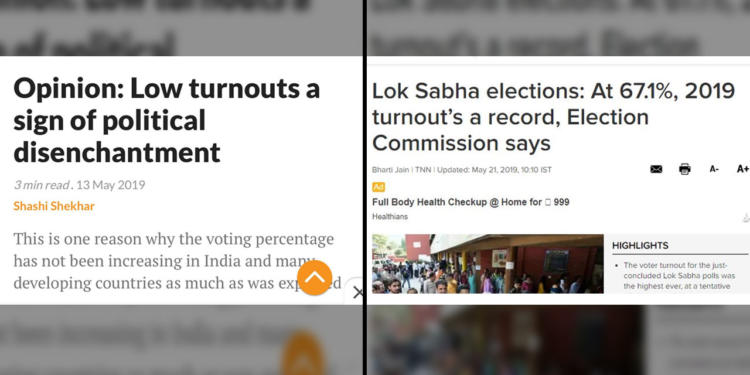To expect objectivity from Indian media is a futile endeavor. However, one at least expects a sense of ground reality from the people in the ‘ivory towers’ entrusted with informing the public about ‘public opinion’. Unfortunately, that is completely missing from Indian media. As a result, we often come across opinions and analysis diametrically opposite to the ground reality, the public sentiment and at certain times, even plain, hard facts.
Traditionally media in India has been a closed club of individuals, born out of a perpetual quid pro quo with certain political forces. This patronage of political forces, however, had just resulted in the dampening of objectivity and marred this noble profession with agenda driven subjectivity. Media in India for long had just been a tool to put out this subjectivity and present it as the ultimate truth. The advent of Social media transformed the media from a one-way loudspeaker to a two-way telephone providing the erstwhile receivers the ability to respond and question. Loss of monopoly over media didn’t go down well with the elite groups who have now employed an improvised strategy to mold the truth and fit it into narratives driven by their Political agendas.
Regardless of this massive transformation claims made to ‘know it all’ still remain and shadow the political discourse in India to great lengths. In one curious example of similar nature “Low turnouts a sign of political disenchantment” an article published in Livemint by Shashi Shekhar, Editor-in-Chief of Hindustan Time, also follows the same trait. The article which is based on the premise of low voter turnout is not only dissociated from the truth but also presents a slanted view of what voter turnout represents.
“Compared to the present election, a higher josh (greater enthusiasm) was witnessed during the first general election in independent India. In 1951, 61.16 % people exercised their franchise.” However, in the first-ever general election to the Lok Sabha in 1951, there were only 17.3 crore registered voters and the voter turnout was 45.7%, the lowest ever turnout till date and the present general elections have noted an electoral participation of around 67.11% that is expected to further increase after Vellore goes into polls. This is the highest ever polling percentage recorded in the history of Indian politics.
Even the wave election following the assassination of Indira Gandhi only saw a turnout of 64.01% in 1984-85. The highest increase in the turnout between 2014 and 2019 was in Madhya Pradesh (71.2% from 61.61 %, a jump of 9.59 followed by Himachal Pradesh (71.52% from 64.45%).
“The common man, constantly struggling with this endless hype and hoopla is neither indifferent nor particularly enthusiastic.” This assumption is purely based on low voter turnout which stands nullified as data suggests the 2019 general election saw the highest voter turnout.
This article sure underlines some aspects which should be pondered upon however misses out to compare the thoughts with the ground realities in a diligent manner. Elections in India have been seeing similar trends with various journalists coming out with their analysis of the political situation in India however only to be proved largely dissociated with the ground reality. In the event of contrary outcomes, the very same journalists then come out with bizarre theories to discredit the results instead of correcting their mistakes.































